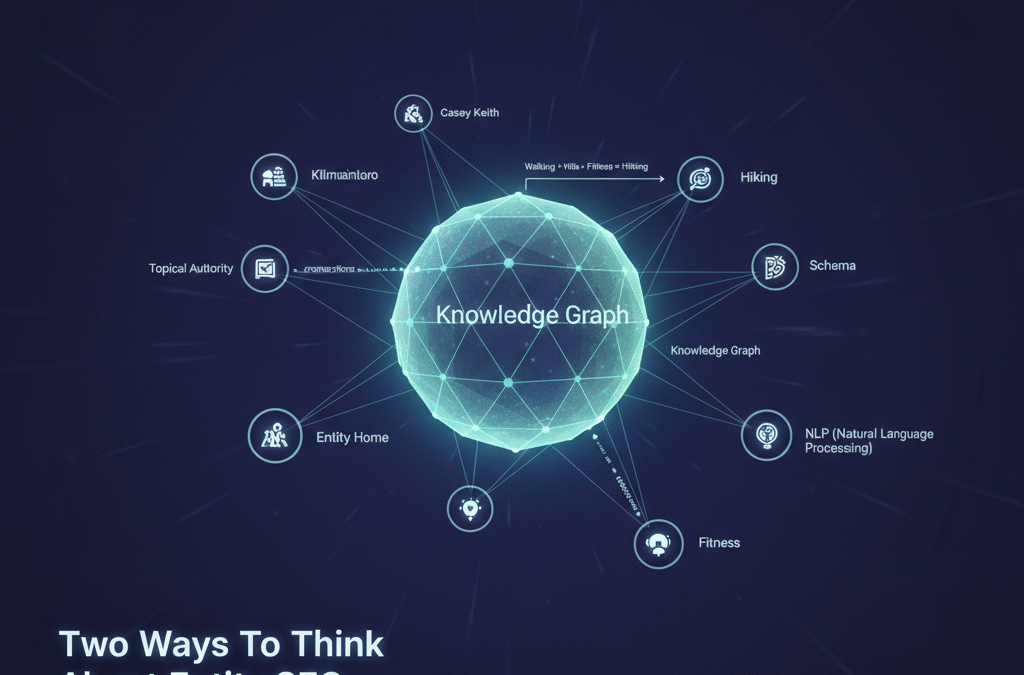All right, before we get going, let’s just admit it. Old-school SEO was basically “sprinkle the magic keyword dust and hope the Google gods smile.” That party’s over. These days, Google is trying to actually understand what you mean, not just what you typed. Spoiler alert: that is where entities walk in.
What’s an entity, really?
You don’t need a PhD for this. If you can name it, it is probably an entity. A person, a company, a product, Kilimanjaro, hiking, pizza. Even concepts like “fitness.” Google groups ideas into entities and connects them. Put “walking,” “hills,” and “fitness” together and, obviously, you are basically pointing to “hiking,” even if you never typed the word. You’ve probably noticed this when your search results magically seem to know what you meant. Creepy-good, right?
I mean, I still type like I’m arguing with autocorrect, and Google figures it out. Different studies might call it different things. I don’t know. It’s in between there someplace. You can learn more about entities in this other article I wrote.
Knowledge Graph vs. Knowledge Panel
Quick bathroom break level clarity:
- Knowledge Graph is Google’s giant machine-readable encyclopedia of entities and how they relate.
- Knowledge Panel is the box you see in search results when Google is confident enough to show a neat summary about something.
If the panel pops up for your brand, nice. If not, no meltdown. The real win is getting Google’s brain to understand you correctly in the first place.
Schema is Google’s native language
Now, before you panic, schema markup is not wizardry. Think of it like handing Google your page’s cheat sheet. You wrote a normal page for humans. Great. Schema tells Google, in structured data, “This page is about X. X is the same as this Wikipedia entry. Here are the key attributes.” It is supporting evidence. Like giving the kid the study notes after the boring textbook.
No, schema is not only for rich snippets. Yes, it helps Google lock in what you mean. And yes, I’ve seen it help pages get understood without stuffing keywords like you are trying to win a hot dog contest.
How Google detects entities
Google reads your page with natural language processing. It tries to figure out whether “engine” means a car part or a search engine based on the words around it. It breaks a page into hundreds of potential entities, then tries to reconcile all that with what it already knows. If your info around the web is messy or contradictory, Google’s “plate” looks cracked. Your job is to hand it the finished plate. Neat, consistent, obvious.
The three-step playbook I use
I keep this absurdly simple because I have to remember it without a PowerPoint.
- Pick an Entity Home
One page is the official home for the thing. For a person, a product, a brand. That is where Google should reconcile fragmented facts. Treat it like the source of truth. - Write a clear description
Explain it like you are talking to a smart 12-year-old. Who is it, what is it, what does it do, and who is it for. Add schema that repeats the critical facts. Keep it tight. No fluff. Obviously. - Corroborate across the web
Make sure your facts match everywhere that matters. Company listings, profiles, data sources, industry directories, government registries. If the web repeats the same facts you wrote, Google’s confidence shoots up. When your grocery bill looks like a car payment, you want your SEO at least paying you back with certainty.
Topics vs. entities
I’m sure a lot of you are going, “Aren’t topics and entities basically the same thing?” Close enough for most practical work. The way I run it day to day:
- Treat the brand, person, product as the core entity.
- Build topical authority around it with tightly related entities.
- Link content together internally so the relationships are obvious.
I work left to right: define the entity cleanly, then stack the topic layers on top. You can do it the other way and meet in the middle. Either way, connect the dots.
Moving from keywords to entities without breaking your brain
Here is the transition plan that does not involve burning your old spreadsheets:
- Stop counting keywords. Start identifying what the page is fundamentally about.
- List the supporting entities. If the page is about banana splits, you will probably mention bananas, ice cream, bowls, chocolate sauce, whipped cream, recipes. You do not need to say “bowl” ten times. Just show the right context.
- Use schema to mark the main thing. Tell Google what the page is primarily about, then reference the canonical identifiers for clarity.
- Link smart internally. Connect related pages so Google can follow the logic. The goal is a site-level knowledge graph where each page’s role is obvious.
- Expect pleasant surprises. When you nail entities, Google will rank you for queries you did not target word-for-word, because the meaning matches. That is when you know you are doing grown-up SEO.
How to become an authority on a topic
No magic. Just work. Here is the recipe I use:
- Publish content that answers real questions with correct detail. Not just opinions dressed up as facts.
- Cover the topic’s core entities thoroughly, then expand naturally into related subtopics.
- Get recognized by peers and cited in places that actually matter. Third-party corroboration is rocket fuel.
- Keep your facts consistent everywhere. If you change a title, date, or claim, update it across your whole ecosystem. I got a few regrets. Letting old bios rot is one of them.
Site-level knowledge graph in plain English
Yes, schema plus internal links can form a knowledge graph of your site’s ecosystem. That is the point. Each page should be clearly “about” one primary entity, with sensible links to related entities. Do this right and you are not shouting louder. You are speaking clearer.
Practical checklist you can use today
- Pick the Entity Home for your brand, products, and key people.
- Write clear, child-proof descriptions. No jargon salad.
- Add schema that matches the on-page facts.
- Standardize facts across profiles and directories.
- Map your pillar topics. Create or update content to cover the supporting entities.
- Link pages to show relationships, not just to “push juice.”
- Review your brand search result. If it is confusing, fix your ecosystem until it looks like your business card.
All right, that is the straight talk. The keyword era was the training wheels. Entities are the real bike. Get your facts straight, connect your ideas, speak Google’s language, and let the machine confidently match you with the right people. If you do that, you will stop chasing hacks and start building something that lasts.
To learn more about entities and semantics in SEO, I have a course called Treasure Map that you can take. I also welcome you to join my Facebook group, SEO Training Camp.

